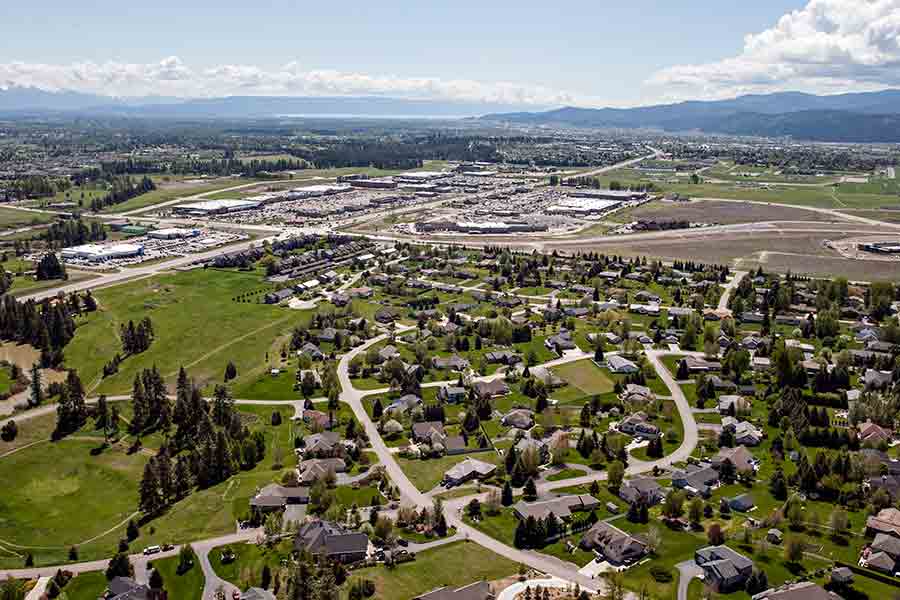In 2007, Flathead County was still enjoying the fruits of booming growth and riding a robust housing market.
Little did the valley know that it was headed into a difficult, transformative period during and after the Great Recession, or that the economic landscape would begin to shift away from the industries on which it used to survive.
As Flathead County continues to recover and hit new population and economic milestones, here’s a look back at the last decade and how we got here, by the numbers.
Who Lives and Works Here?
In 2007, the U.S. Census Bureau listed Flathead County’s population at 88,245 people. The county was still basking in the glow of the major boom of the early 2000s, hitting peak employment at 41,000 jobs. The median income was $45,122, and the median price for a home was around $250,000. By the end of 2007, the unemployment rate was 5.4 percent, whereas the annual unemployment rate in 2006 was a mere 3.9 percent.
Then the Great Recession made its way into the valley, causing a massive slowdown on the housing industry. According to Jim Kelley of Kelley Appraisals, the median residential sale price for a home in 2008 fell to $239,000 and bottomed out in 2011 at $180,000.
Unemployment hit hard. According to the Montana Department of Labor and Industry (DLI), by December 2008, Flathead County had an unemployment rate of 10.4 percent, with a year average of 6.7 percent. The jobless rate continued to grow, with an average of 11.8 percent of the workforce unemployed in 2009, 12 percent in 2010, and back to 10.9 percent in 2011. Neighboring counties saw higher rates; Lincoln County’s unemployment rate averaged 15 percent in 2010.
Median incomes in Flathead County dropped as well, down to $44,013 in 2008, back up above $45,000 in 2009, and to $42,278 in 2010. It was again above $45,000 in 2012 and reached more than $46,000 by 2013.
The county’s population grew by fewer than 1,500 people total from 2009 to 2012, with 2010 seeing an addition of only 18 people to the county.
As the recession’s ripples started to slow, the county began to come alive again. The population started to increase, adding 1,433 people in 2013 alone as the economy rebounded. By 2014, the average unemployment here was 6.5 percent; the latest stats put it at 6.3 percent in March 2017.
Residential prices began to creep up, as did the number of units sold. The number of foreclosures began to fall, as did all types of distressed sales. There were 820 homes sold in 2008, but that figure was back up to 1,380 in 2014 and then 1,680 in 2016 with a median price of $255,000, above the 2007 level.
In March of this year, Flathead County’s population was expected to exceed 100,000 by summer.
Economy: From Timber to Health Care
In 2007, 4,357 private employers in Flathead County employed 36,889 people, according to the DLI, with total wages in the county reaching more than $1.1 billion. Three years later, 4,051 private businesses were employing 32,587 people on average, and the county’s total wages dropped by about $100 million.
Some of the recession’s largest victims were mining, logging, and construction, which made up a considerable bulk of the county’s economy in 2007. Nationwide, there was a decrease of more than 1.9 million workers in construction, logging, and mining combined.
In Flathead County, construction accounted for more than $151 million in total wages in 2007, according to DLI. That dropped to $141 million in 2008 and plummeted to $83.4 million by 2011. Manufacturing experienced a similar decline, accounting for 3,633 jobs and $153.7 million in wages in Flathead County in 2007, and falling to 2,480 jobs and about $117.8 million in wages in 2011.
Forestry and logging made up about $7.5 million in wages in Flathead County in 2007, but that dropped to $4.9 million by 2011. Wood product manufacturing, which included 41 businesses accounting for about $70 million in wages, dropped to 35 businesses producing about $47 million in wages by 2011.
In 2016, the timber industry suffered another blow after Weyerhaeuser closed two former Plum Creek mills and an administrative office, leaving 172 people unemployed. The closures reduced the number of mills in Montana to eight.
These traditional economic pillars began to fall to the wayside as employment in retail, tourism and health care took on bigger roles. According to the University of Montana’s Bureau of Business and Economic Research, non-resident visitors spent $518 million in 2012, equaling about $342 million in economic activity to the region, which translated to 5,000 jobs and total wages of more than $177 million. By 2016, tourists spent $635.4 million in Flathead County.
Health care employment skyrocketed, becoming the county’s leading employer by 2016 with about 6,300 jobs and an annual total payroll of about $313 million, or roughly 21 percent of the county’s total payroll.
According to the latest data from the DLI, 2016 showed a rebound in employers and wages, hitting 4,428 private employers, 38,983 people employed on average, and a total payroll of nearly $377 million through the third quarter of 2016.
Construction, still a major player in the economic landscape, has made a turnaround, with 730 businesses employing 3,098 people on average as of the third quarter of 2016, which was the latest data available from the DLI. Development hit $129 million in Kalispell in 2016, which is more than the previous two years combined and higher than any of the boom years in 2005-2007.
